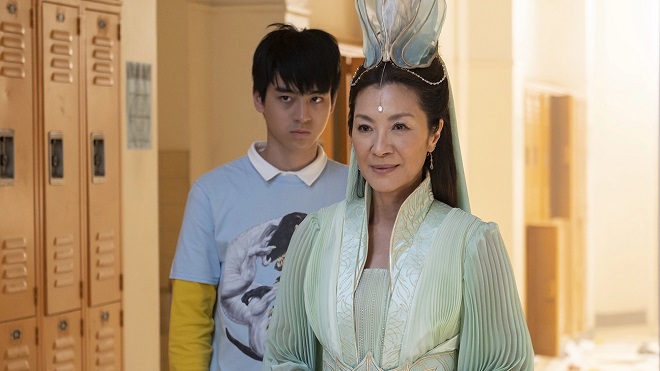Quarantine Control #166: Spring King’s Godzilla

In a sure sign of how bad our climate has literally become, the east coast of the United States has been blanketed in a thick and toxic smog thanks to a large wildfire from Nova Scotia in Canada. The fire has been largely contained, but a fair portion of the neighboring United States is realizing just how large and significant it was thanks to the orange and gray haze hovering above. The air quality has plunged in cities where it already wasn’t great, like New York City and Philadelphia, and climate change has been a factor by creating the dry atmospheres that created the conditions for more fires. The pandemic, however, showed us how people will bend themselves into pretzels to pretend that horrifying elements of our society don’t exist, so absolutely expect this to be another occurrence that comes and goes with no actions undertaken to address it.
Geoffrey Barnes
Shin Godzilla (2016)
Source: Crunchyroll
Episodes: 1 movie (the first in the “Shin” movie series)

I had the feeling that I would enjoy Shin Godzilla upon watching it, after putting it off for years for reasons unknown. I always had certain expectations when going into Japanese Godzilla films, which serve as cheesy good times with okay-at-best acting and plenty of destruction from Godzilla and whatever fearsome force he’s fighting. The thought that this description wouldn’t entirely apply to Shin Godzilla was intriguing, a movie with “Shin” in its name because it hews closer to the older films in terms of its themes and how it portrays Godzilla. That Hideaki Anno, of Gunbuster and Neon Genesis Evangelion, was on as director helped — let me be honest here.
Instead of the anti-heroic figure Godzilla is depicted as in prior Japanese Godzilla films from the 1990s and 2000s, the titular character here is ostensibly shrouded in mystery. His mere appearance in Tokyo is enough to cause mass panic, and an immediate response from the Japanese government. It’s a more realistic reaction from the country, with the focus entirely resting on how the people and politicians would logically respond to an unknown and fearsome creature they can’t easily handle. Bad decisions are unsurprisingly made, and the matter is serious enough that Japan’s allies at NATO inevitably must get involved, including the United States. But the movie tackles these issues and solely focuses on the panic and reaction, while not resorting to an inane level of xenophobia and nationalism some previous films included.
The plot for the movie is as threadbare as necessary, but Anno and the production crew knew it didn’t need to be any more complicated. The escalating battle between Godzilla, the people, and military forces was more than entertaining enough. Shin Godzilla’s strength lies in how it trusts the viewer to discern the more heroic and villainous figures involved. Just because Godzilla isn’t a blatant anti-hero this time doesn’t mean he may not still be one. Perhaps the response from NATO-aligned countries, particularly you-know-who, is so overboard in their desire to stop Godzilla that they might do more damage than he ever could. The best kinds of movies allow the viewer to think in this way, this one among them. I’m still thinking about it right now.
Anno utilized the directorial style he perfected through animation in this film, skills seamlessly carried over into a live-action format. His approach here is unsurprisingly reminiscent of Evangelion, only partly because he directed this movie as a sort of break from the Rebuild of Evangelion films. The subtle style featuring experts hurriedly responding to a disaster they have no idea how to handle, some nervously and others with a snarky bite, is intriguing for nearly every moment, and segues well with the action. This is all accompanied by a great soundtrack from Shiro Sagisu, also of Evangelion. The jazzier theme will stick with me, but I got a kick out of the drum-heavy track (and its variants) that I thought was ripped right out of Evangelion until I discovered that it was only paying homage to it. Even if that track was taken from Eva, and even though the overall soundtrack is thin, it all works for the scenes it’s utilized in.
The movie is well produced in terms of most special effects and cinematography, an achievement despite the low-ish budget of around $10 million. There are warts, like the low and muffled sound effects. My guess is that these were intentional homages to the older Godzilla films inserted to work around the budget, but some larger explosions are a bit jarring for a movie in high definition. But only a “bit.”
There’s also the character of Kayoco Anne Peterson (Satomi Ishihara), the special envoy to the President of the United States. It was, at times, difficult to take her seriously as a character supposedly born in the US with a very thick English accent, performed by an actress very clearly not an English speaker. But this was far from enough to bring the entire movie down, especially when she moves around and acts with the charismatic stylishness of an Evangelion character like Misato or Ritsuko.
A key reason why I enjoyed Shin Godzilla is because it was only concerned with being a single, standalone movie, a rarity for big and grand franchise film these days. A few story elements are left open, as Anno is wont to do, but I’m hoping the next Japanese film, scheduled for November of this year, will at least inherit a similar tone and not go back to what ran the franchise into the ground after Final Wars in 2004. (Even though Final Wars is itself a delectably insane film.) Until then, I have Shin Ultraman and Shin Kamen Rider to tackle, which I don’t plan on waiting seven years to watch.
Angela Moseley
Shin Megami Tensei: Devil Summoner 2: Raidou Kuzunoha vs. King Abaddon (2008)
Source: PS2
Episodes: 1 long ass video game

If you catch any of our livestreams, you may have noticed I’ve been playing Shin Megami Tensei: Devil Summoner 2: Raidou Kuzunoha vs. King Abaddon since the middle of January. On early Monday morning I finally completed the game after a grueling six-hour stream. (A huge thank you to Geoff and Drew who stayed up past their bedtimes to hang out with me as I battled my way to the finish line.) My thoughts on the game from when I wrote about it four weeks ago haven’t changed since seeing the credits roll. In this case, the Jimquisition is completely correct in their assessment about not needing to finish a game in certain situations.
For me to have changed my opinion on Raidou Kuzunoha vs. King Abaddon, the final battle or the ending would have had to be mind-blowing. It wasn’t. What I got was a Megaten slog that wasn’t really more difficult than anything I faced. The final boss was made artificial harder than it should have been because of a serious lack of magnetite (magic points) restoration items. This lead me to a long battle of doing little more than chip damage. The actual tactics the boss used weren’t enough to cause me serious harm as long as I dodged most of his attacks. It was just a battle of attrition. My psychical stamina versus the boss’s health bar.
When the credits finished and I had some time to think about the game, I mostly enjoyed the journey. Again, I think the game was padded out far too much for its own good. Raidou Kuzunoha vs. The Soulless Army was a streamlined Megaten experience that I appreciated. Not perfect, but the story and characters were enjoyable. It was nice to have an RPG in the Shin Megami Tensei franchise that could be completed in less than 30 hours. It took me twice as long to finish the sequel. That’s with me deciding to ignore a bunch of side quests at the end. Not that it’s possible to finish all the side quests in one playthrough. Getting all of them requires at least one new game plus run. I’m sure some fans loved how much longer the game was, but to me, it felt like busy work with no real purpose aside from the chance to grind.
If I had a choice, I’d combine the streamlined story and lack of side quests from The Soulless Army with the improved gameplay of King Abaddon. Simply having the ability to roll to avoid attacks made the combat feel so much better. Having two demons on the field to form a three-member party just made battles flow so much more quickly. I didn’t find myself in as many protracted battles as I did in the original game. (Not counting my hour and a half long fight against the final boss and his three forms.) Having random encounters limited to certain areas of the game instead of being everywhere made navigation and investigations so much easier.
The changes I didn’t like were having a shared pool of mag between Raidou and the demons. In most battles, it can be restored by stunning enemies. However, when it runs out or enemies are stingy with mag, it’s impossible to restore mid-battle without a soma. Stocking up on somas is impossible, as you’re only allowed to carry one at a time. I also dislike how Raidou’s gun was pretty much nerfed. Sure, you didn’t have to buy and juggle various types of ammo this time around, but the gun felt like an afterthought a majority of the time. Finally, I’m torn on the inclusion of demon negotiation. Sure, this put Raidou closer in line with the mainline Megaten games, but I found myself not really missing negotiation in the original. At the same time, negotiations brought additional personality to the game.
As for the alignment I received, for a moment I thought I’d made it to the neutral route. However, I had been so deep in the law aligned hole, that not even a series of chaotic choices at the end of the game could change that. At first, I was troubled, but considering my choice affected who died and who lived, I’m ultimately satisfied with the decisions I made. The character who was the spark for all tragedy that occurred in this game, chose to atone for those mistakes. By doing so, they gave another character a chance to live freely. In the chaos and neutral routes, the character who gets a second chance at life decides to sacrifice it to save everyone else. Learning this left a sour taste in my mouth, reinforcing my satisfaction with the ending I received.
I ultimately enjoyed my time with Shin Megami Tensei: Devil Summoner 2: Raidou Kuzunoha vs. King Abaddon. If I had a redo, I probably would have played this game offline instead of streaming it given its length. That said, I hope Atlus considers revisiting Raidou someday. I’d love to play a third game. Heck, if Soul Hackers can randomly receive a sequel, maybe there’s hope for this Taisho era detective.
Joseph Daniels
One of the topics that’s been on people’s minds lately, especially here on Damage Control, is the permanence of digital media. We’ve gotten to the point in the streaming wars where companies are actually going to be offering less content instead of more content. From losing out on stuff like Infinity Train on HBO Max to losing out on Willow on Disney+, I can’t help but wonder if this is going to hurt the services in the long run. Whatever short term gains will be had from moves like this will likely be erased when people decide they don’t really need to resubscribe and can do without their services for a month. This is especially true since the whole inflation scam is making all of our other bills go up as well.
The fact that this is also timed to coincide with the latest writer’s strike is rather suspicious for entirely different reasons.
Will Netflix drop a bunch of stuff? At this point, they probably shouldn’t. They already lost a lot of content when various companies decided to start their own streaming services, and a lot of what they have left are their originals. If they were to drop their originals, the service would be gutted.
Perhaps, as services become less valuable to customers, us customers should choose to forego these services for a month or so. Maybe instead of paying for the next month’s HBO Max, its subscribers should decide not to subscribe until July. Maybe we can wait a bit on that Disney+ renewal. If companies don’t want to provide access to as much content as we had access to a month prior, maybe we don’t want to pay for that service any more. Or we subscribe when a new season of our favourite show comes out and then cancel our subscriptions for another year.
So this week, for Quarantine Control, instead of talking about good stuff to watch, I’m going to encourage cutting the cord, so to speak. Most of what we recommend are from streaming services anyway. I’ll probably return to recommending stuff next week, but if you wanted to cut yourself off for a month, I’d very much encourage it.
This Week’s Short Film
Spring (2019)
Right on schedule, the death cult is already discussing how the air quality isn’t actually bad for you. And here health officials are only asking people to mask up outside for a few days at most. Ridiculous, but it’s another sign showing how these people will make their voices heard to millions regardless of how dire the climate landscape becomes. Good luck, everyone.





